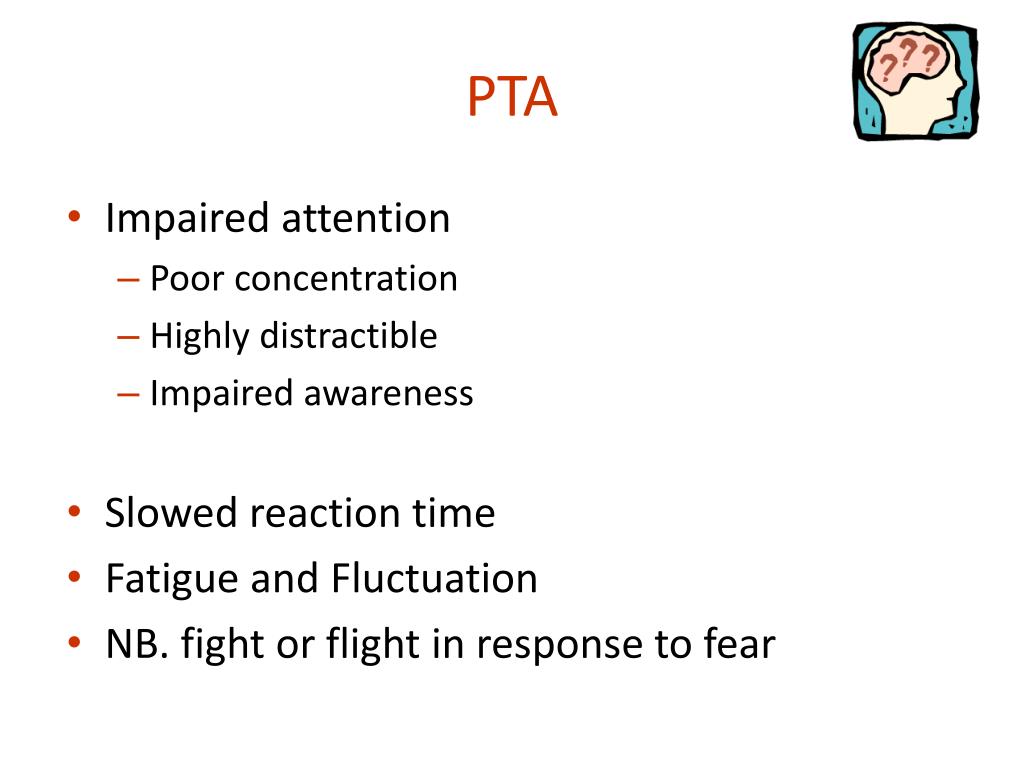

There is a paucity of studies evaluating functional outcomes relating to PTA duration beyond 1 year post-injury, limiting long-term care planning. These findings highlight that across different follow-up periods and different outcome metrics, longer PTA duration is invariably associated with worse outcomes, which increases the burden of care. ( 14) found PTA duration over four weeks was associated with severe disability in adults as measured by the Glasgow outcome scale. Increased PTA duration has also been linked to decreased productivity at 1 year post-injury ( 12) as well as higher rates of severe disability and poor recovery 2 years post-injury ( 13). used PTA duration as a predictor for outcomes after TBI and found that patients with PTA 30 days ( 11). patients with a PTA duration >1 week ( 10). found that shorter PTA duration (≤1 week) predicted greater cognitive performance and less disability at 6 months post-injury vs.

In individuals with complicated mild TBI, Hart et al. The cognitive sequelae following TBI often includes post-traumatic amnesia (PTA) characterized by disorientation, confusion, restlessness, inability to recall events, poor attention, and agitated behavior ( 6– 9). TBI can have a devastating impact ranging from impaired physical capability to altered cognition, which impedes functional independence ( 2). These factors highlight the importance of TBI research to improve early diagnosis, prognosis, and treatment to maximize functional recovery and reduce the burden of care for individuals with TBI. In addition to the financial impact, given the increased burden of care faced by caregivers of patients with TBI, it is not surprising that caregivers report being “overburdened with responsibilities” ( 4) and suffer from a high level of caregiver distress ( 5). TBI accounts for substantial health care costs in the US in 2010, there were 21.4 billion dollars in charges for TBI-related admissions as well as 8.2 billion dollars charged for ED visits ( 3). The CDC estimated that ~16% of annual hospitalizations due to a traumatic injury were related to TBI ( 2). According to the Centers for Disease Control and Prevention (CDC), in 2010 there were ~2.5 million emergency department visits, hospitalizations, and deaths due to TBI in the U.S. Traumatic brain injury (TBI) is one of the leading causes of death and disability worldwide ( 1). These results may help the rehabilitation team and family in planning care post rehabilitation discharge. In conclusion, individuals with esPTA have increased short- and long-term burden of care and the presence of ICH during hospitalization increased the odds of experiencing esPTA. The odds of developing esPTA was ~3 times higher for individuals with ICH vs. Unlike the non-esPTA group where FIM ® total score plateaued 1 year post-injury, FIM ® total score continued to improve up to 2 years post-injury for the esPTA group.

Repeated measure ANOVA revealed greater burden of care based on FIM ® total scores ( p < 0.001) from admission to 5-year follow-up for the esPTA group compared to the non-esPTA group (PTA ≤ 28 days). The FIM ® instrument was chosen as the outcome measurement as it is a widely used functional assessment in the rehabilitation community. Three hundred and forty-two individuals with moderate to severe TBI enrolled in the Northern California TBI Model System (TBIMS) of Care were included in this study. This study aims to evaluate the burden of care in individuals with extremely severe PTA (esPTA PTA >28 days) from acute inpatient rehabilitation admission to 5 years post-injury as well as the association between intracranial hypertension (ICH Intracranial pressure (ICP) ≥20 mmHg) and esPTA status. Few studies have looked at the effect of prolonged PTA on the functional outcomes beyond 1 year post-injury. Post-traumatic amnesia (PTA) is characterized by a state of disorientation and confusion following traumatic brain injury (TBI). 4Department of Orthopedic Surgery, Stanford University, Stanford, CA, United States.3Physical Medicine and Rehabilitation, Santa Clara Valley Medical Center, San Jose, CA, United States.2Department of Neurosurgery, Stanford University, Stanford, CA, United States.1Rehabilitation Research Center, Santa Clara Valley Medical Center, San Jose, CA, United States.Quach 1 * †, Reza Ehsanian 1,2 †, Benjamin Dirlikov 1, Samantha Sechrist 1, Jyodi Mohole 1, Stephen McKenna 2,3,4, Linda Isaac 1 and Thao T.


 0 kommentar(er)
0 kommentar(er)
